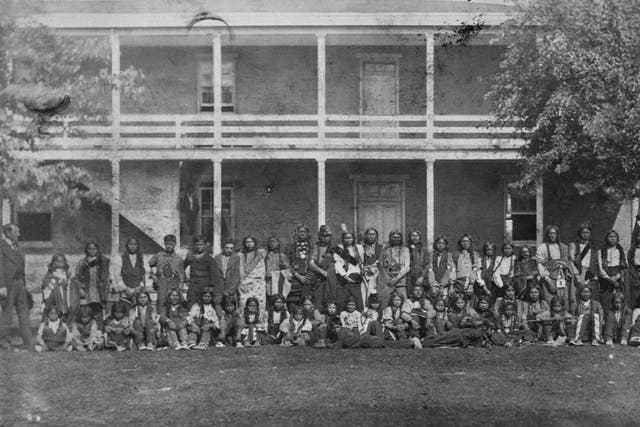

That was the mindset under which the U.S. government forced tens of thousands of Native American children to attend “assimilation” boarding schools in the late 19th century. Decades later, those words—delivered in a speech by U.S. cavalry captain Richard Henry Pratt, who opened the first such school in Carlisle, Pennsylvania—have come to symbolize the brutality of the boarding school system.
The history of this forced assimilation is far from settled. On August 7, 2017, the U.S. Army began exhuming the graves of three children from the Northern Arapaho tribe who had died at Pratt’s Carlisle Indian Industrial School in the 1880s. The children’s names were Little Chief, Horse and Little Plume—names they were forbidden to use at the school.
Students at Carlisle and the roughly 150 other such schools that the government opened were susceptible to deadly infections like tuberculosis and the flu. During Carlisle’s operation between 1879 and 1918, nearly 200 other children were buried in the same cemetery as the Northern Arapaho boys, according to The Washington Post.
Carlisle and other boarding schools were part of a long history of U.S. attempts to either kill, remove, or assimilate Native Americans. In 1830, the U.S. forced Native Americans to move west of the Mississippi to make room for U.S. expansion with the the Indian Removal Act. But a few decades later, the U.S. worried it was running out of places to relocate the country’s original inhabitants.
“As white population grew in the United States and people settled further west towards the Mississippi in the late 1800s, there was increasing pressure on the recently removed groups to give up some of their new land,” according to the Minnesota Historical Society. Since there was no more Western territory to push them towards, the U.S. decided to remove Native Americans by assimilating them. In 1885, Commissioner of Indian Affairs Hiram Price explained the logic: “it is cheaper to give them education than to fight them.”
1 / 16 : The Library of CongressAs part of this federal push for assimilation, boarding schools forbid Native American children from using their own languages and names, as well as from practicing their religion and culture. They were given new Anglo-American names, clothes, and haircuts, and told they must abandon their way of life because it was inferior to white people’s.
Though the schools left a devastating legacy, they failed to eradicate Native American cultures as they’d hoped. Later, the Navajo Code Talkers who helped the U.S. win World War II would reflect on the strange irony this forced assimilation had played in their lives.
“As adults, [the Code Talkers] found it puzzling that the same government that had tried to take away their languages in schools later gave them a critical role speaking their languages in military service,” recounts the National Museum of the American Indian.
Once they returned home, Native American children struggled to relate to their families after being taught that it was wrong to speak their language or practice their religion.
They resisted government attacks to take their children—and paid the price.
Sequoyah spent 12 years working on a writing system for his nation’s language.
In addition to the Northern Arapaho in Wyoming, the Rosebud Sioux of South Dakota and native people of Alaska are also seeking the return of children’s remains from Carlisle, reports Philly.com. Yet if the results of Northern Arapaho’s search are any example, this may prove to be quite difficult.
On August 14, 2017, the Army sent the remains of Little Chief and Horse back to their relatives on the Wind River Reservation. The Northern Arapaho will bury them on August 18, 2017. Little Plume, however, was not sent back because he wasn’t found. In what was supposed to be his coffin, archaeologists instead discovered the bones of two others who couldn’t have been Little Plume because their ages didn’t match his.
Researchers aren’t sure who those two people are or where Little Plume could be, and the Northern Arapaho haven’t stated whether they’ll continue to search for him. For now, the Army has reburied the two people found in his coffin, and Little Plume remains one of Carlisle’s many missing children.
From Comanche warriors to Navajo code talkers, learn more about Indigenous history.